Search
- Page Path
-
- HOME
- Search
- Original Article
- Neonatology (Perinatology)
- Differential roles of interleukin-6 and adrenomedullin in early diagnosis and mortality predictions in late-onset neonatal sepsis
- Emilly Henrique dos Santos, Gabriel Acca Barreira, Mariana Okay Saippa, Maria Carolina Pires Cruz, Karen Alessandra Rodrigues, Ronaldo Arkader, Thelma Suely Okay
- Clin Exp Pediatr. 2025;68(6):463-471. Published online December 23, 2024
-

Question: Can adrenomedullin (ADM) or interleukin-6 (IL-6) detect late-onset neonatal sepsis (LOS) at admission (area under the curve [AUC]>0.90) as an early diagnostic marker?
Finding: Only IL-6 consistently distinguished survivors from nonsurvivors (AUC>0.90) on admission and antibiotic treatment days 3 and 7. C-reactive protein level identified infections from day 3 but failed to predict outcomes (AUC<0.70).
Meaning: IL-6 level can improve LOS diagnosis and prognosis.
- Review Article
- Gastroenterology
- Practical concepts and strategies for early diagnosis and management of eosinophilic gastrointestinal disorders in East-Asian children
- Byung-Ho Choe
- Clin Exp Pediatr. 2025;68(3):185-198. Published online November 13, 2024
-
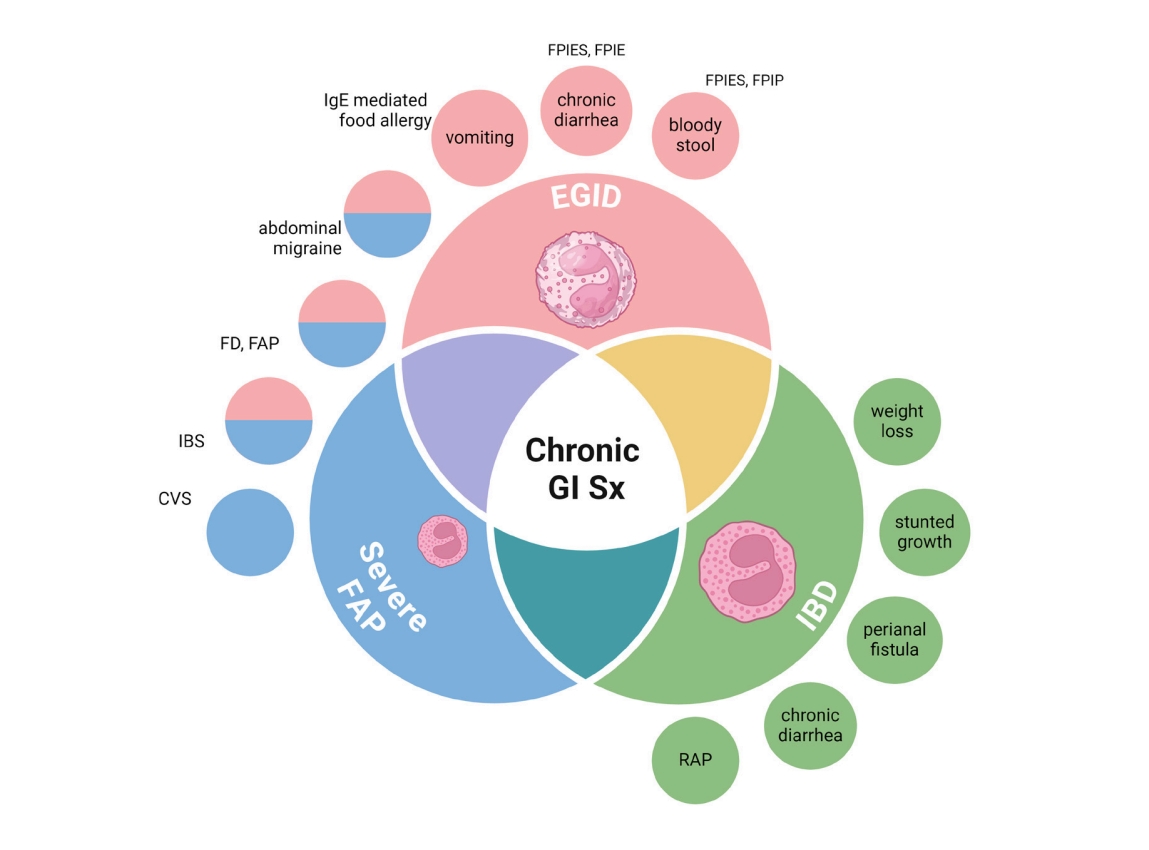
Eosinophilic gastrointestinal disorders (EGIDs) often coexist with functional gastrointestinal disorders (FGIDs) and other IgE or non-IgE mediated GI diseases. Diagnosing EGIDs requires a high index of suspicion and a comprehensive approach to differentiate them from conditions like inflammatory bowel disease. Tests such as fecal calprotectin and biopsies aid in severe cases. Maintaining a food diary helps identify triggers for long-term elimination. Awareness and education are key to effective management.
- Infection
- Community-acquired pneumonia in children: updated perspectives on its etiology, diagnosis, and treatment
- Ki Wook Yun
- Clin Exp Pediatr. 2024;67(2):80-89. Published online June 14, 2023
-

· Most commonly confirmed causes of community-acquired pneumonia (CAP) in children are Mycoplasma pneumoniae (8%–40%) and respiratory syncytial virus (15%–20%).
· Pyogenic bacteria, most commonly Streptococcus pneumoniae (40%–50%) and Streptococcus pyogenes (10%–25%), are detected in 2%–5% of children hospitalized with CAP.
· CAP should be diagnosed conservatively according to clinical and radiological criteria.
· The etiology should be identified via appropriate test result interpretation.
- Gastroenterology
- Update on eosinophilic gastrointestinal disease beyond eosinophilic esophagitis in children
- Hye Ran Yang
- Clin Exp Pediatr. 2023;66(6):233-239. Published online January 3, 2023
-

· Eosinophilic gastrointestinal disease (EGID) is uncommon, with a prevalence of 1–30/100,000 in the general population; however, it is increasing worldwide.
· The diagnosis of EGID is based on histopathological findings of endoscopic mucosal biopsy in which tissue eosinophils are counted in each gastrointestinal tract segment of patients with chronic or recurrent gastrointestinal symptoms.
· Individualized treatment strategies, including adequate dietary and pharmacological therapy, may help improve outcomes of children with EGID.
- Allergy
- Diagnosis and management of asthma in infants and preschoolers
- Hai Lee Chung
- Clin Exp Pediatr. 2022;65(12):574-584. Published online April 19, 2022
-
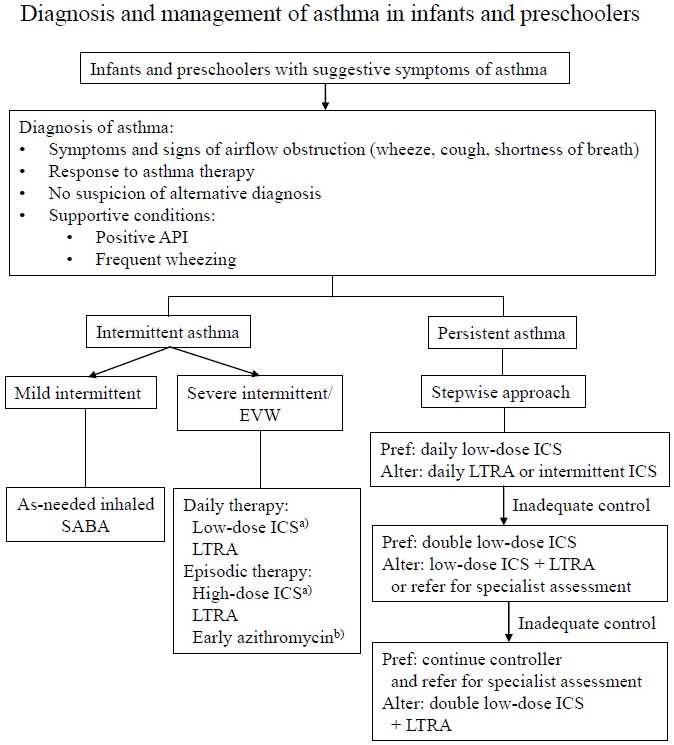
· Asthma in infants and preschoolers involves heterogeneous phenotypes.
· Asthma diagnosis is based on symptom patterns, therapeutic responses, and the presence of risk factors with careful consideration of differential diagnosis.
· Daily inhaled corticosteroid therapy remains the most effective strategy for managing persistent asthma symptoms irrespective of phenotype.
· Future research, including genetic and molecular studies, is needed to develop a clear definition of asthma and personalized therapeutic approaches.
- Neurology
- Neonatal seizures: diagnostic updates based on new definition and classification
- Eun-Hee Kim, Jeongmin Shin, Byoung Kook Lee
- Clin Exp Pediatr. 2022;65(8):387-397. Published online April 4, 2022
-
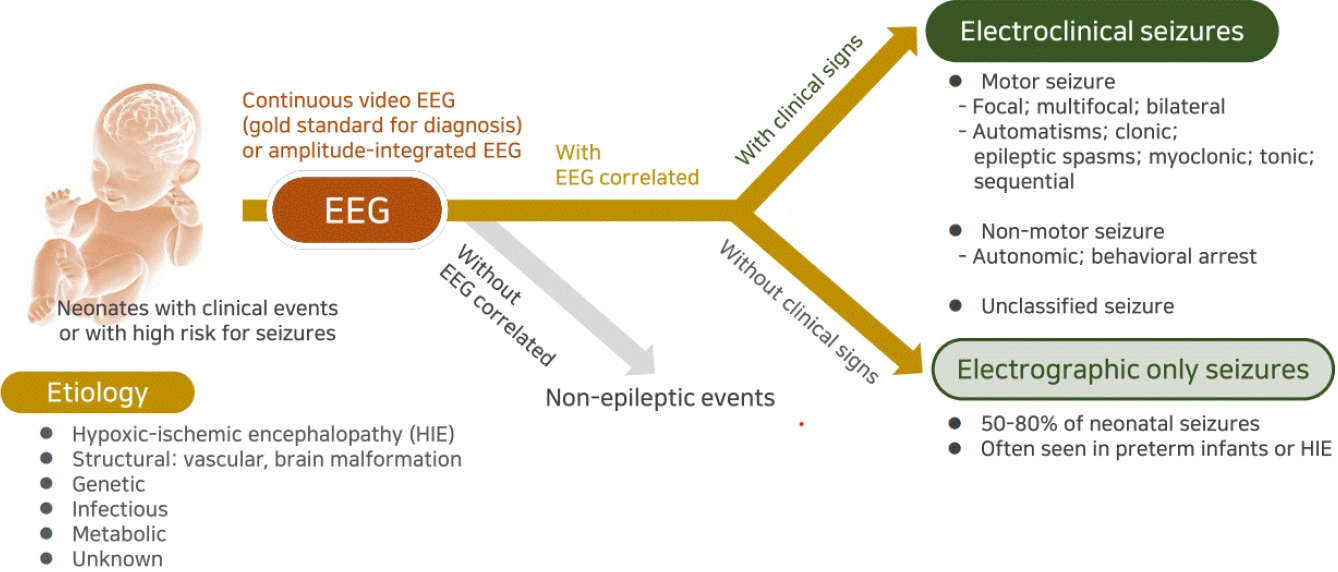
· Neonatal seizures are often electrographic-only seizures without clinical signs; therefore, the identification of electrical seizure activity on electroencephalography is the gold standard for diagnosis.
· Clinical signs of neonatal seizures are divided into motor or nonmotor seizures, and motor seizures are mostly focal or multifocal.
· Most neonatal seizures are caused by acute symptomatic etiologies, but in cases of intractable seizures, structural, genetic, or metabolic etiologies should be investigated.
- Original Article
- Endocrinology
- Zinc transporter 8 autoantibody in the diagnosis of type 1 diabetes in children
- Nur Rochmah, Muhammad Faizi, Siti Wahyu Windarti
- Clin Exp Pediatr. 2020;63(10):402-405. Published online October 6, 2020
-
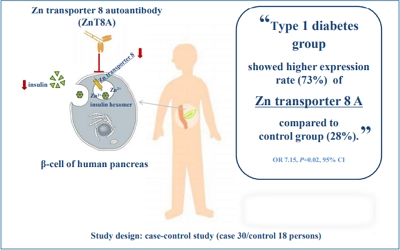
Question: Can zinc transporter 8 autoantibody (ZnT8A) be used for diagnosing type 1 diabetes (T1D)?
Finding: Twenty-two of 30 subjects with type 1 diabetes (73.3 %) were positive for ZnT8A compared to 5 of 18 controls (27.8%).
Meaning: ZnT8A has potential for clinical applications in the diagnosis of T1D.
- Review Article
- Genetics and Metabolism
- Neurofibromatosis type I: points to be considered by general pediatricians
- Eungu Kang, Hee Mang Yoon, Beom Hee Lee
- Clin Exp Pediatr. 2021;64(4):149-156. Published online July 15, 2020
-
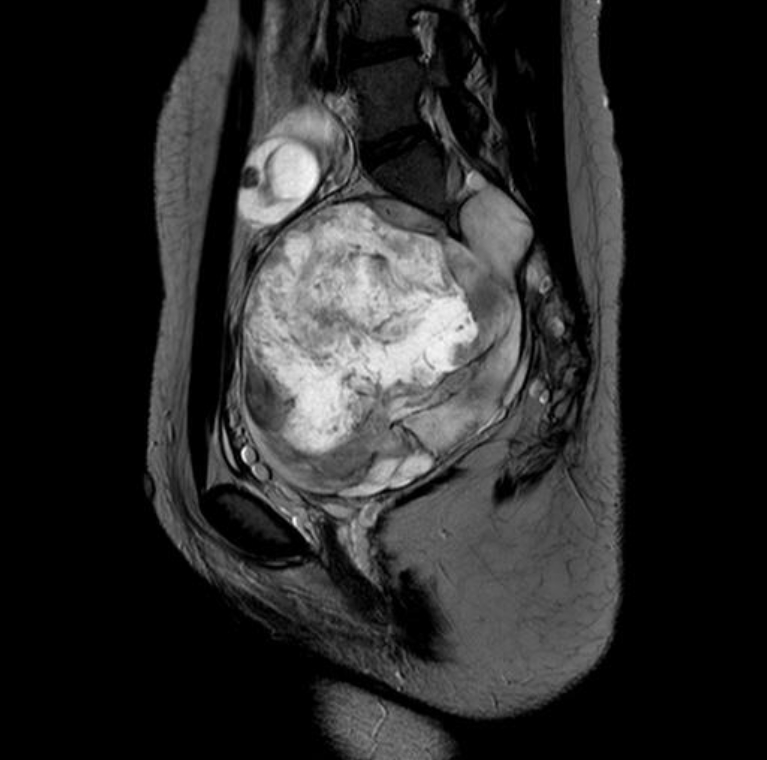
Neurofibromatosis type 1 (NF1), a prevalent genetic disease that is transmitted in an autosomal dominant manner, is characterized by multiple cutaneous café-au-lait spots and neurofibromas as well as various degrees of neurological, skeletal, and neoplastic manifestations. The clinical features of NF1 increase in frequency with age, while the clinical diagnosis can remain undetermined in some pediatric patients. Importantly, affected patients...
- Original Article
- Allergy
- Asthma predictive index as a useful diagnostic tool in preschool children: a cross-sectional study in Korea
- Dong Hyeon Lee, Ji-Won Kwon, Hyung Young Kim, Ju-Hee Seo, Hyo-Bin Kim, So-Yeon Lee, Gwang-Cheon Jang, Dae-Jin Song, Woo Kyung Kim, Young-Ho Jung, Soo-Jong Hong, Jung Yeon Shim
- Clin Exp Pediatr. 2020;63(3):104-109. Published online November 8, 2019
-

Question: Is physician-diagnosed current asthma in preschool children associated with the asthma predictive index, atopic sensitization, or pulmonary function test?
Finding: Physician-diagnosed current asthma in preschool children was associated with the asthma predictive index, but not with spirometry, methacholine provocation test, fractional expiratory nitric oxide level, and atopic sensitization.
Meaning: Physician-diagnosed asthma in preschool children may be different from classic atopic asthma in school children or adolescents.
- Guideline
- Nutrition
- Clinical practice guideline for the diagnosis and treatment of pediatric obesity: recommendations from the Committee on Pediatric Obesity of the Korean Society of Pediatric Gastroenterology Hepatology and Nutrition
- Dae Yong Yi, Soon Chul Kim, Ji Hyuk Lee, Eun Hye Lee, Jae Young Kim, Yong Joo Kim, Ki Soo Kang, Jeana Hong, Jung Ok Shim, Yoon Lee, Ben Kang, Yeoun Joo Lee, Mi Jin Kim, Jin Soo Moon, Hong Koh, JeongAe You, Young-Sook Kwak, Hyunjung Lim, Hye Ran Yang
- Clin Exp Pediatr. 2019;62(1):3-21. Published online December 27, 2018
-

The Committee on Pediatric Obesity of the Korean Society of Pediatric Gastroenterology, Hepatology and Nutrition newly developed the first Korean Guideline on the Diagnosis and Treatment of Obesity in Children and Adolescents to deliver an evidence-based systematic approach to childhood obesity in South Korea. The following areas were systematically reviewed, especially on the basis of all available references published in...
- Review Article
- Nutrition
- How to approach feeding difficulties in young children
- Hye Ran Yang
- Clin Exp Pediatr. 2017;60(12):379-384. Published online December 22, 2017
-

Feeding is an interaction between a child and caregiver, and feeding difficulty is an umbrella term encompassing all feeding problems, regardless of etiology, severity, or consequences, while feeding disorder refers to an inability or refusal to eat sufficient quantities or variety of food to maintain adequate nutritional status, leading to substantial consequences, including malnutrition, impaired growth, and possible neurocognitive dysfunction....
- Original Article
- Gastroenterology
- Risk factors of delayed diagnosis of acute appendicitis in children: for early detection of acute appendicitis
- Jea Yeon Choi, Eell Ryoo, Jeong Hyun Jo, Tchah Hann, Seong Min Kim
- Clin Exp Pediatr. 2016;59(9):368-373. Published online September 21, 2016
-
Purpose This study examined the risk factors of a delayed diagnosis of acute appendicitis in children undergoing an appendectomy.
Methods This retrospective study involved children aged below 18 years, who underwent an appendectomy. After dividing them into a delayed diagnosis group and nondelayed diagnosis group according to the time interval between the initial hospital visit and final diagnosis, the risk factors of delayed...
- Cardiology
- Usefulness of anterior uveitis as an additional tool for diagnosing incomplete Kawasaki disease
- Kyu Jin Lee, Hyo Jin Kim, Min Jae Kim, Ji Hong Yoon, Eun Jung Lee, Jae Young Lee, Jin Hee Oh, Soon Ju Lee, Kyung Yil Lee, Ji Whan Han
- Clin Exp Pediatr. 2016;59(4):174-177. Published online April 30, 2016
-
Purpose There are no specific tests for diagnosing Kawasaki disease (KD). Additional diagnostic criteria are needed to prevent the delayed diagnosis of incomplete Kawasaki disease (IKD). This study compared the frequency of coronary artery lesions (CALs) in IKD patients with and without anterior uveitis (AU) and elucidated whether the finding of AU supported the diagnosis of IKD.
Methods This study enrolled patients diagnosed...
- Diagnostic characteristics of supplemental laboratory criteria for incomplete Kawasaki disease in children with complete Kawasaki disease
- Hyun Ok Jun, Jeong Jin Yu, So Yeon Kang, Chang Deok Seo, Jae Suk Baek, Young-Hwue Kim, Jae-Kon Ko
- Clin Exp Pediatr. 2015;58(10):369-373. Published online October 21, 2015
-
Purpose In 2004, the American Heart Association (AHA) had published an algorithm for the diagnosis of incomplete Kawasaki disease (KD). The aim of the present study was to investigate characteristics of supplemental laboratory criteria in this algorithm.
Methods We retrospectively examined the medical records of 355 patients with KD who were treated with intravenous immunoglobulin (IVIG) during the acute phase of the disease....
- Usefulness of pelvic ultrasonography for the diagnosis of central precocious puberty in girls
- Jung Yu, Ha Young Shin, Sun Hee Lee, You Sung Kim, Jae Hyun Kim
- Clin Exp Pediatr. 2015;58(8):294-300. Published online August 21, 2015
-
Purpose It is difficult to differentiate between central precocious puberty (CPP) and premature thelarche (PT) in girls. The aim of this study was to investigate the diagnostic usefulness of pelvic ultrasonography to distinguish between CPP and PT in girls with early breast development.
Methods This study included girls with early breast development who visited the clinic between January 2012 and December 2013. Clinical,...
- Review Article
- Kawasaki disease in infants
- Jung Sook Yeom, Hyang Ok Woo, Ji Sook Park, Eun Sil Park, Ji-Hyun Seo, Hee-Shang Youn
- Clin Exp Pediatr. 2013;56(9):377-382. Published online September 30, 2013
-
Kawasaki disease (KD) is an acute febrile illness that is the predominant cause of pediatric acquired heart disease in infants and young children. Because the diagnosis of KD depends on clinical manifestations, incomplete cases are difficult to diagnose, especially in infants younger than 1 year. Incomplete clinical manifestations in infants are related with the development of KD-associated coronary artery abnormalities....
- Noninvasive diagnosis of pediatric nonalcoholic fatty liver disease
- Hye Ran Yang
- Clin Exp Pediatr. 2013;56(2):45-51. Published online February 25, 2013
-
Because nonalcoholic steatohepatitis can progress towards cirrhosis even in children, early detection of hepatic fibrosis and accurate diagnosis of nonalcoholic fatty liver disease (NAFLD) are important. Although liver biopsy is regarded as the gold standard of diagnosis, its clinical application is somewhat limited in children due to its invasiveness. Noninvasive diagnostic methods, including imaging studies, biomarkers of inflammation, oxidative stress,...
- Eosinophil-derived neurotoxin: a novel biomarker for diagnosis and monitoring of asthma
- Chang-Keun Kim
- Clin Exp Pediatr. 2013;56(1):8-12. Published online January 29, 2013
-
Asthma is associated with increased levels of eosinophils in tissues, body fluids, and bone marrow. Elevated levels of eosinophil-derived neurotoxin (EDN) and eosinophil cationic protein (ECP) have been noted in asthma patients. Higher levels of EDN and ECP are also associated with exacerbated asthmatic conditions. Thus, EDN, along with ECP, may aid the diagnosis and monitoring of asthma. Several groups...
- Diagnosis of incomplete Kawasaki disease
- Jeong Jin Yu
- Clin Exp Pediatr. 2012;55(3):83-87. Published online March 16, 2012
-
Several authors suggested that the clinical characteristics of incomplete presentation of Kawasaki disease are similar to those of complete presentation and that the 2 forms of presentation are not separate entities. Based on this suggestion, a diagnosis of incomplete Kawasaki disease in analogy to the findings of complete presentation is reasonable. Currently, the diagnosis of incomplete Kawasaki disease might be...
- Case Report
- Misdiagnosis of fetus-in-fetu as meconium peritonitis
- Yoon Joo Kim, Se Hyung Sohn, Ju Young Lee, Jin A Sohn, Eun Hee Lee, Ee Kyung Kim, Chang Won Choi, Han Suk Kim, Beyong Il Kim, Jung Hwan Choi
- Clin Exp Pediatr. 2011;54(3):133-136. Published online March 31, 2011
-
Fetus-in-fetu (FIF) is a rare congenital condition in which a fetiform mass is detected in the host abdomen and also in other sites such as the intracranium, thorax, head, and neck. This condition has been rarely reported in the literature. Herein, we report the case of a fetus presenting with abdominal cystic mass and ascites and prenatally diagnosed as meconium...
- Review Article
- Juvenile idiopathic arthritis: Diagnosis and differential diagnosis
- Ki Hwan Kim, Dong Soo Kim
- Clin Exp Pediatr. 2010;53(11):931-935. Published online November 30, 2010
-
Juvenile idiopathic arthritis (JIA) is comprised of a heterogeneous group of several disease subtypes that are characterized by the onset of arthritis before the age of 16 years and has symptoms lasting at least 6 weeks. The previous classification of JIA included seven different categories, whereas its current classification was compiled by the International League of the Association for Rheumatology,...
- Practical stepwise approach to rhythm disturbances in congenital heart diseases
- June Huh
- Clin Exp Pediatr. 2010;53(6):680-687. Published online June 23, 2010
-
Patients with congenital heart diseases (CHD) are confronted with early- and late-onset complications, such as conduction disorders, arrhythmias, myocardial dysfunction, altered coronary flow, and ischemia, throughout their lifetime despite successful hemodynamic and/or anatomical correction. Rhythm disturbance is a well-known and increasingly frequent cause of morbidity and mortality in patients with CHD. Predisposing factors to rhythm disturbances include underlying cardiac defects,...
- Diagnosis of neonatal seizures
- Hee Jung Chung, Yun Jung Hur
- Clin Exp Pediatr. 2009;52(9):964-970. Published online September 15, 2009
-
Neonatal seizures are generally not only brief and subtle but also not easily recognized and are usually untreated. In sick neonates, seizures are frequently not manifested clinically but are detected only by electroencephalography (subclinical EEG seizures). This phenomenon of electroclinical dissociation is fairly common in neonates. On the other hand, neonates frequently show clinical behaviors such as stiffening, apnea, or... -
- Assessment of retinopathy of prematurity (ROP) revisited
- Jeong Hun Kim, Young Suk Yu
- Clin Exp Pediatr. 2009;52(1):22-27. Published online January 15, 2009
-
Retinopathy of prematurity (ROP) is a major cause of blindness that affects premature infants. With advances in neonatology, ROP is likely to emerge as the most serious problem of vision loss in children even in developed countries; such a situation could be called the third epidemic of ROP. However, controversy and uncertainty still surround favorable outcomes of ROP. For successfully... -
- Neuromuscular disorders in children : Diagnosis and treatment
- Jong Hee Chae
- Clin Exp Pediatr. 2008;51(12):1295-1299. Published online December 15, 2008
-
Inherited muscle diseases are heterogeneous with varying genetic etiologies and present with common symptoms and signs, including weakness, motor developmental delay, and hypotonia. To diagnose these various diseases, a meticulous family and clinical history, physical and neurological examinations, laboratory findings with electromyography, muscle biopsy, and genetic testing are needed. Here, I review several inherited muscle diseases, with a focus on... -
- Differential diagnosis of abdominal masses in children
- Ki Woong Sung
- Clin Exp Pediatr. 2008;51(8):787-791. Published online August 15, 2008
-
Enlargement of organs or other solid tissues usually presents as an abdominal mass. Often, abdominal masses in children are found by an unsuspected parent or by a physician during a routine examination. Most masses have no specific signs or symptoms. Abdominal masses in children require immediate attention. History and physical examination may provide clues to the diagnosis. Ultrasound examination is... -
- Juvenile rheumatoid arthritis
- Dong Soo Kim
- Clin Exp Pediatr. 2007;50(12):1173-1179. Published online December 15, 2007
-
The diagnosis of juvenile rheumatoid arthritis (JRA) is based on patient's age at disease onset, symptom duration, gender, and clinical manifestations. JRA is of unknown origin, begins under the age of 16, and persists for a minimum of 6 weeks. JRA is categorized into three principal types, systemic, oligoarticular and polyarticular. Infection, other connective tissue diseases, malignancy, trauma, and immunodeficiency... -
- Non-epileptic paroxysmal events during sleep - Differentiation from epileptic seizures -
- In Kyu Lee
- Clin Exp Pediatr. 2007;50(8):726-731. Published online August 15, 2007
-
This review describes the wide spectrum of paroxysmal events during sleep in infancy and childhood. The differential diagnosis between sleep-related non-epileptic paroxysmal events and epileptic seizures is difficult in special occasions. The nocturnal frontal lobe seizure and of the more common non- epileptic paroxysmal events during sleep are described. The main differentiating features characterizing parasomnias are: onset in early... -
- The diagnosis of pediatric sinusitis
- Chang-Keun Kim
- Clin Exp Pediatr. 2007;50(4):323-327. Published online April 15, 2007
-
Although most clinicians now agree that sinusitis can afflict children of all ages, appropriate diagnosis remain controversial. Sinusitis is one of the most challenging diagnoses for a clinician, because there is a lack of validated diagnostic criteria for acute rhinosinusitis. Symptoms generally include nasal congestion, purulent nasal discharge, and cough .The physical examination is often unsuccessful in confirming the diagnosis.... -
- Fever and rash
- Jin Han Kang
- Clin Exp Pediatr. 2007;50(2):132-137. Published online February 15, 2007
-
Patients with febrile illness and skin rashes need full and immediate attention. In general, these diseases show mild manifestations and good prognosis. However, causalities of some diseases with fever and rash may be life threatening or trivial. So, the differential diagnosis for those patients is extensive. A through history, a careful physical examination and close observation of clinical progress are... -
-

-
-
6.02024CiteScore98th percentilePowered by
-
Impact Factor3.6
-
- TOPICS
- ARTICLE CATEGORY
- Editorial Office
-
Korean Pediatric Society
#1606 Seocho World Officetel, 19 Seoun-ro, Seocho-ku, Seoul 06732, Korea
Tel: +82-2-3473-7306 Fax: +82-2-3473-7307 E-mail: office@e-cep.org
Clinical and Experimental Pediatrics is an open access journal. All articles are distributed under the terms of the Creative Commons Attribution NonCommercial License (http://creativecommons.org/licenses/by-nc/4.0/)
Copyright © 2025 by Korean Pediatric Society.











